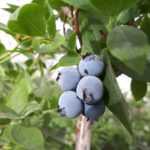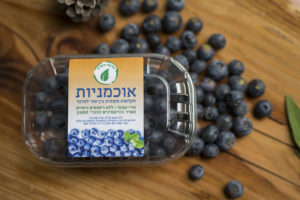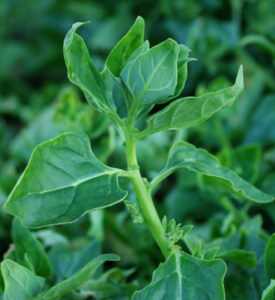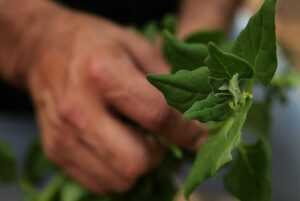We’re picking up your empty boxes again!
As corona restrictions slacken, we are delighted to reassume the task of collecting your empty Chubeza cartons for us to recycle. Kindly leave them outside your door, and feel free to slit the tape and flatten them to save space. Our delivery people will pick them up when they deliver your boxes.
Thanks!

_____________________________________________
Blueberries! Yummy!!!
Over the past three years, on a small plot of land in Tekoa, Gadi and Tamar have been growing blueberry shrubs that paint their surroundings in glorious hues of blue and purple. Gadi Afik, an agronomist specializing in growing blueberries, is responsible for mushroom growing on the Tekoa farm. He works together with Tamir Deutsch, an organic farmer and owner of Helkat HaSadeh, an organic vegetable garden CSA. The two joined forces to confront the tough challenge of growing blueberries in Israel.
Blueberries need special conditions to grow. They grow best in acidic soil, which is why they are grown on a separate surface inside very large containers. Cold weather makes them happy, so frost warms Gadi and Tamir’s hearts.
Their blueberries, pesticide-free, boast a very high nutritional value rich in antioxidants, vitamins C and K and various minerals. Blueberries are said to prevent inflammation of blood vessels, reduce cholesterol, and are recommended as a fruit portion for diabetics thanks to their ability to reduce sugar levels in the blood.
And we haven’t said anything the taste…Words just can’t describe the goodness.
Blueberries – 20 NIS for 125 gr
You deserve a blueberry treat! Order this minute via our order system
______________________________________
How do we know that spring is here?
Well… one sure clue is the New Zealand spinach in your vegetable boxes.
The spring and summer spinach we eat in Israel is not actually spinach. It’s not even a relative or a local, and albeit an immigrant to boot, it is one of the few greens that actually survives the hot Israeli summer. Its many names all indicate its origins: Sea Spinach, (Captain) Cook’s Cabbage, Warrigal Greens (named after an Australian wild dog, otherwise known as Dingo) and Botany Bay Spinach. In the native Māori language it’s termed Kokihi, and in South Africa it is known as Duneweed.
All of these names describe a bit of its nature: this is a leafy crawling plant that grows mainly on the coast. A native of Australia and New Zealand, it was used extensively by the natives, and Captain Cook himself brought it to the European world. But before we mix you up like a spinach salad, let’s start from the beginning:
The plant’s scientific name is Tetragonia tetragonioides, and it belongs to the Aizoaceae family, characterized by fleshy plants that thrive along the seashores, in sands and dunes, and also in the desert. It has been native to Australia and New Zealand for centuries, where the aborigines and native Maoris would gather it for food. When the Europeans reached the continent, they were taught which plants were edible, inside information which enabled them to survive. They coined the local plants and animals used for sustenance (including the wonder-plant tetragonia) “bush tuckers” (or as we say, Baladi).
Upon his fleet’s arrival to the Eastern coast of Australia in 1770, Captain Cook was justifiably concerned lest his sailors contract scurvy, a disease caused by lack of vitamin C. So whenever they reached shore, the captain would set out in search of good fresh leafy greens to boost their diets. In Australia, his botanist chef found the tetragonia, and after enjoying its taste and nutritious value, they brought it home to England.
The Brits, already very fond of greens, were delighted to receive this exotic plant, and by the beginning of the nineteenth century it was to be found growing in the finest of English vegetable gardens. Afterwards, there came a period when the tetragonia was passed over for hybrids and other “advanced” plants, but over the recent decades, in keeping with the worldwide trend for local, homegrown products, the venerable plant is experiencing a comeback. White-aproned Australian chefs now gather it in the fields or purchase it from gourmet farmers. In leafy-green-loving Asia, too, it was happily received, growing across Eastern Asia and used as a substitute for Asian greens in stir-fried vegetable dishes.
This is how it grows, spread out and sprawling:
Though genetically unrelated to spinach, tetragonia received its name because it is used as a spinach substitute—but with one major edge over its namesake: Unlike spinach, which requires a cold climate and will not germinate in extreme heat or will bloom prematurely, New Zealand spinach is heat-resistant. On the other hand, it is very sensitive to cold, and frost will completely destroy it. This special relationship resulted in the New Zealand spinach becoming a good substitute for spinach during summer, while true spinach assumes the stage in winter.
In Israel, the substitution game became even more complex, with a small link to our chubeza as well. During the siege of Jerusalem, the city’s residents were encouraged to plant rooftop vegetable gardens, using their sewage water for irrigation. This is when the idea arose to gather wild mallow (chubeza). Schoolchildren were organized to go out and gather mallow leaves, which were then passed on to Tnuva, which packaged and marketed them as “New Zealand Spinach.” Around the world in just a few words: a Jerusalem mallow, marketed as New Zealand spinach, serves as a substitute for true spinach (which has its origins in Iran).
If you wish to grow this wonder plant yourself, following suit of so many gardeners worldwide who have transplanted it into their plots of earth, there are several things you should know: First, it grows easily and enthusiastically, demanding no special pampering. So much so that in various parts of New Zealand and the United States it has become a weed which farmers try to get rid of, but usually it is very friendly. Like many other local “homegrown” plants, it is strong and does not attract too many pests or diseases, another reason for it to replace the sensitive spinach. Its seeds sprout slowly, due to an impenetrable seed shell (remember, it is accustomed to growing in moist areas in the southern hemisphere where the seeds’ problem was how not to go bad before sprouting…). The best way to help it sprout is to soak the seeds in cold water for 24 hours prior to seeding, or in hot water for three hours.
The mildly salty taste of New Zealand spinach is similar to that of true spinach, making it a proper substitute. But they do not resemble each other one bit! Indeed, New Zealand spinach is green and edible, but this is as far as the resemblance stretches. The New Zealand mate’s diamond-shaped leaves are much smaller, fleshier and usually sport jagged edges. It can substitute for spinach in any recipe, and in some dishes can replace Swiss chard, with whom it shares a fleshy texture. This fleshiness of the New Zealand spinach leaves allows them to retain more volume in cooking, thus when substituting for spinach or Swiss chard, use only half the amount of leaves called for in the recipe. (Note that the recipes in our recipe section are original Australian recipes meant for New Zealand spinach, thus the quantities are correct).
When you cook New Zealand spinach, separate the leaves from the coarser-textured stems which can create uneven cooking. It is not recommended to consume these greens raw: the leaves contain cartonoid antioxidants which are important nutrients, but in their raw form they are oxalates which complicate digestion, particularly for those who are sensitive in that realm (e.g., gallstone or other kidney problem sufferers.) To remove most of the oxalates for easier digestion, blanch the New Zealand spinach for a few minutes, and then wash the leaves. Bon Appetite!
Wishing all a relaxed, pleasant and healthy week,
Alon, Bat-Ami, Dror, Orin and the entire Chubeza crew
WHAT’S IN THIS WEEK’S BOXES?
______________________________
Monday: Zucchini/bell peppers, potatoes, slice of pumpkin, beets, cucumbers, tomatoes, leeks/onions, New Zealand spinach, parsley/coriander/dill, lettuce, celery/parsley root.
Large box, in addition: Swiss chard/kale, carrots, cabbage/garlic.
FRUIT BOXES: Bananas, nectarines, oranges/red grapefruit, apples.
Wednesday: Zucchini/bell peppers/turnip/Facus, potatoes, slice of pumpkin/cabbage/garlic, beets, cucumbers, tomatoes, fresh onions, New Zealand spinach/kale, parsley/coriander/dill, lettuce, celery.
Large box, in addition: Swiss chard, carrots, parsley root.
FRUIT BOXES: Bananas, nectarines/avocado, oranges/red grapefruit, apples.
________________
New Zealand Spinach Recipes:
New Zealand Spinach and Parsley Pesto
New Zealand Spinach Recipe From the Cauldrons of Captain Cook’s Chef






